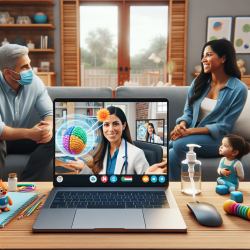Key Recommendations for Telehealth ABA Services
Based on the research, here are some key practice recommendations for delivering telehealth ABA services effectively:
1. Caregiver Support
- Discuss the role of the caregiver before starting telehealth services and continue regular discussions throughout the course.
- Build and maintain rapport with caregivers through regular communication and engagement.
- Determine the most appropriate telehealth model for each family, considering the caregiver's availability and skills.
2. Rapport Building
- Allocate the first few telehealth sessions to pairing and building rapport with the client.
- Use activities and items that can be delivered via telehealth to engage the client and establish a positive relationship.
- Monitor the client's behavior to ensure the presence of good rapport.
3. Preference Assessments and Reinforcers
- Conduct regular preference assessments to identify potential reinforcers that can be delivered via telehealth.
- Consider using various types of preference assessment procedures adapted for telehealth.
- Work with caregivers to minimize competing reinforcers and distractions in the client's environment.
4. Session Frequency and Length
- Be flexible in determining the session length and frequency based on the client's needs and engagement levels.
- Incorporate short breaks to maintain client engagement and compliance.
5. Program Adaptation
- Assess whether a given program requires adaptation for telehealth and make necessary modifications.
- Adapt materials, target responses, and prompts to suit the telehealth environment.
- Plan for generalization probes across settings to ensure skills acquired in telehealth generalize to in-person settings.
6. Behavior Management
- Conduct a functional behavior assessment and develop a behavior intervention plan if challenging behaviors arise.
- Monitor the client's behavior continuously and communicate regularly with caregivers.
- Assess the appropriateness of telehealth direct service if challenging behaviors persist.
7. Technological Issues
- Ensure a reliable internet connection, software, and hardware for telehealth sessions.
- Be familiar with various telehealth application's functions and troubleshoot technical issues as they arise.
- Work with caregivers to facilitate the arrangement of a context that minimizes technological issues.
Case Studies
The research article presents case studies of two boys, Rob and Kelly, who received telehealth ABA services. These case studies highlight the practical application of the recommendations and provide insights into the challenges and successes of telehealth ABA services.
Rob's sessions focused on intraverbals, tacts, and mands, with modifications made to suit the telehealth environment. Preference assessments helped identify reinforcing activities that kept Rob engaged throughout the sessions. Kelly's sessions included social skills programs with peers, and his engagement was maintained through various telehealth-friendly games and activities.
Conclusion
Telehealth ABA services offer a valuable option for delivering therapy to children with autism, especially in remote or underserved areas. By implementing the recommendations from the research article, practitioners can improve their telehealth skills and create positive outcomes for their clients.
To read the original research paper, please follow this link: Preliminary Practice Recommendations for Telehealth Direct Applied Behavior Analysis Services with Children with Autism.










